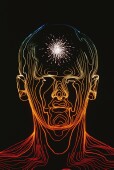
WEDNESDAY, Feb. 17 (HealthDay News) — New brain-scan research is providing insight into how you decide what things are worth.
Researchers at Duke University Medical Center found that specific areas of the brain were activated in male college students as they evaluated female faces. The findings, they report, suggest that the brains were doing two things: figuring out the quality of the experience of viewing the faces and determining what they would trade to see a particular face again.
In the experiment, researchers scanned the brains of the heterosexual male subjects using fMRI technology as they looked at female faces and images of money. Later, the participants were asked if they’d pay more or less money to look at faces that were more or less attractive.
One area of the brain became active as the men figured out how much the faces were worth. Researchers could even predict how much the men would spend to see a more attractive face at a later time.
“One part of the frontal cortex of our participants’ brains increased in activation to more attractive faces, as if it computed those faces’ hedonic — quality of the experience — value,” Scott Huettel, senior author of the new study and director of Duke’s Center for Neuroeconomic Studies, said in a news release from the university. “A nearby brain region’s activation also predicted those faces’ economic value — specifically, how much money that person would be willing to trade to see another face of similar attractiveness.”
“People often respond to images in a very idiosyncratic fashion,” Huettel said. “While we can’t use neuroscience to identify the best images for every person’s brain, we could identify types of images that tend to modulate the right sorts of value signals — those that predict future purchases for a market segment.”
The work was published online Feb. 16 in the Journal of Neuroscience.
More information
Learn more about the brain from the U.S. National Institute of Neurological Disorders and Stroke.

